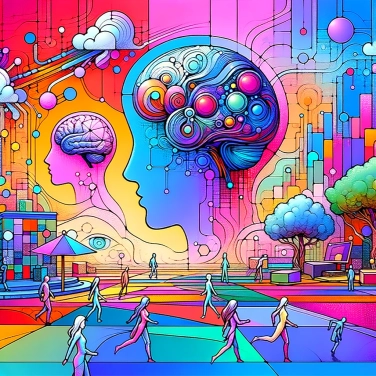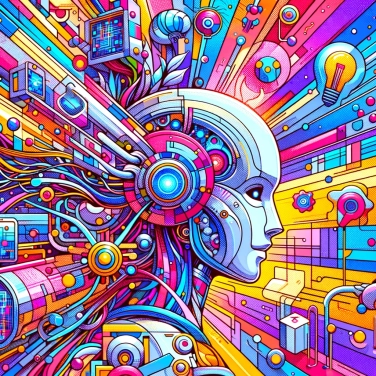Self-learning artificial intelligence can pose ethical challenges as they may develop discriminatory biases based on existing data that already reflects human prejudices, which can lead to unfair or discriminatory decisions.

When an artificial intelligence learns on its own from existing data, it always tends to reproduce some of the biases embedded in that data. For example, if the information used contains stereotypes about certain origins, genders, or ages, the AI will likely do the same, sometimes even without us noticing at first. This can lead to concrete discrimination in important decisions like obtaining a loan, accessing a job, or ranking in higher education. The most problematic aspect is that these biases are often unconscious and automatic, which makes it quite challenging to try to identify and correct them. Without constant vigilance, these algorithms risk amplifying already existing inequalities instead of helping to resolve them.
Artificial intelligence systems that learn on their own, particularly through deep learning, often make decisions without being able to explain exactly why. Even for those who design them, these internal processes resemble a black box. This is where the ethical issues arise: imagine an artificial intelligence refusing credit to someone or rejecting a job application, yet being unable to clearly explain why that decision was made. It then becomes impossible for the concerned individual to contest, understand, or rectify the situation. This opacity also makes quality control or compliance with anti-discrimination laws much more difficult. In short, without transparency, it's hard to trust artificial intelligences, even if they perform well statistically.
Who is responsible when an AI goes haywire, or worse, causes an accident? The problem is that when you let an artificial intelligence learn on its own, it can adopt unpredictable behaviors. It's not always clear whether to blame the developers, the owners, the people who trained it, or even the machine itself (but good luck presenting an AI in front of a judge!). This ambiguity creates a real legal and moral headache, especially in critical situations like with self-driving cars or intelligent medical systems. The result: it's difficult to claim compensation or simply seek justice. This kind of legal void poses a significant ethical puzzle that is still waiting for a clear response from lawmakers.
The self-learning of AI is based on gigantic amounts of data. However, this data often contains sensitive personal information: user preferences, search history, daily habits, precise location, and sometimes even medical information. The massive and automated storage of this data poses a serious issue of privacy, with a high risk of misuse or permanent surveillance of citizens. When AI is capable of continuously monitoring our behavior, individual freedoms are directly threatened, opening the door to a society where every action can be observed, analyzed, and potentially exploited without our knowledge. Without strong protective measures, AI can become a true digital Big Brother capable of tracking our every move.
When an AI learns on its own to do things normally reserved for humans, it inevitably starts to shake up the job market. What often happens is that repetitive or simple jobs that can be automated may disappear quickly: automatic checkouts in stores, administrative processes, or transport with autonomous trucks, for example. As a result, some workers may have to change jobs or skills, and that’s not always easy or possible.
And it’s not just traditional jobs, you know! Even fairly skilled professions, like financial analysts, accountants, writers, or lawyers, are at risk of being partially replaced by efficient and cheaper AIs... The result: economic inequalities may rise because those who own or control the AIs fare better, while others may struggle to make ends meet. If there is no safety net or appropriate support policy, the massive arrival of AIs could significantly exacerbate social imbalances between the winners and losers of these technological advancements.
In 2016, Microsoft launched Tay, a chatbot using self-learning, which was quickly disabled after it made discriminatory remarks learned from users on social media.
Algorithmic bias can be exacerbated by self-learning: for example, an AI used for recruitment at Amazon systematically favored male applications because it had been trained on historical data where men dominated the company.
In 2018, the European Union published guidelines for ethical AI, calling for increased transparency in self-learning systems to ensure fairer and more explainable decisions for the individuals involved.
The term "black box" is often used to describe machine learning systems for which it is difficult, if not impossible, to understand the reasoning behind the decisions or predictions made by the AI.
To limit the opacity of AI systems, researchers and developers use various methods such as explainable AI (XAI), independent audits, and regulations that impose a certain level of transparency regarding the decision-making criteria of publicly used artificial intelligences.
The legal responsibility remains complex to clearly define when an autonomous AI causes damage. This may involve the end user, the manufacturer, the developer, or even the data providers used by the algorithm. International legislative discussions are underway to clarify these aspects.
Yes, the autonomous functioning of AI often involves the massive collection and processing of personal data, sometimes without real guarantees for privacy. This can lead to unintentional but serious infringements on privacy in the absence of strict regulation or strong ethical standards.
The impact on jobs strongly depends on the sector and the type of tasks involved. While some professions are indeed at risk of significantly decreasing due to automation, new jobs may also emerge in areas related to artificial intelligence, continuing education, and technical development.
An algorithmic bias refers to errors or prejudices embedded in algorithms through machine learning, often unintentionally reproducing the biases present in the initial data used for their training.

No one has answered this quiz yet, be the first!' :-)
Question 1/6